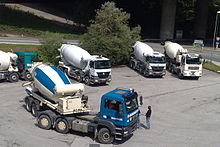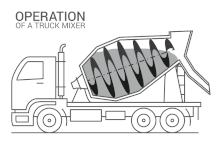Truck mixer

Truck mixers are mobile concrete mixers that transport fresh concrete to the construction site. To do this, the concrete is fed into the rotating drum via the upper hopper. In order to prevent segregation, high-quality concrete may only be transported using truck mixers. Concretes of poor quality can also be transported with standard tipping vehicles.
construction
There are mainly three drum sizes used, which are transported on different trucks .
- In a three-axle truck, the drum is so large that 6–7 m³ can be transported.
- With a four-axle truck it is 8–9 m³. There are also versions from 10 to 12 m³.
- There are also semi-trailers that can transport up to 15 m³. However, these are only rarely found and then mostly in large construction site operations.
Concrete mixers are specially equipped so that they can hand over the concrete professionally at the destination. They also have slides that can be added as required. Most concrete mixers also have a plastic pipe that can be used to direct the concrete over a distance of six meters. For this, however, the concrete must be very fluid. In order to make the concrete flowable, concrete mixers are equipped with a superplasticizer that applies a liquid that does not change the mixing ratio of water and cement when added .
In addition to concrete pumps for pumping concrete in the application area, there are also combined truck-mixer concrete pumps , although the drum is slightly smaller than that of the pure truck mixer.
Spiral blades are arranged on the inner walls of the drum. When driving, the direction of rotation of the drum is such that the concrete is transported forward and falls over the shovels. On arrival at the construction site, the direction of rotation is reversed for emptying so that the concrete is conveyed out to the high opening according to the principle of the screw conveyor, without having to change the position of the drum. The truck manufacturers supply special chassis for the construction of mixing vehicles . Since the loaded concrete builds up on one side due to the rotation of the drum, this results in an uneven load on the carriage, which must be taken into account when designing the axles and springs.
Concrete mixers also carry around 500 liters of water for cleaning purposes.
history
Before the invention of the truck mixer, the concrete required on construction sites was freshly mixed on site. However, this meant that, in addition to the need for a corresponding stationary mixing system, all the ingredients had to be kept on site.
The Stetter company presented the first two-axle concrete truck mixer with a 3.5 cubic meter drum on a truck chassis from Magirus-Deutz at the Hanover Fair in 1958 . This enabled concrete to be premixed centrally in larger mixing plants and then freshly transported to the construction sites. In contrast to transport with conventional flatbed trucks , for example , there was no risk of the concrete setting prematurely on the surface or segregation of the liquid cement during transport, as the concrete in the rotating drum of the truck mixer was constantly being re-mixed. A more controlled and finely dosed unloading of the concrete than with the tipper became possible.
Two different alternatives quickly established themselves for driving the mixing drum: using a hydraulic system driven by the drive motor of the truck chassis or a separate motor on the mixing drum. The former system offered advantages in terms of payload. As early as the 1960s, other companies in addition to Stetter had entered the market, such as Liebherr and Dolberg . Three-axle chassis quickly replaced the initially dominant two-axle vehicles and there were also mixer drums on semi-trailers for particularly large-volume transports .
In addition to loading pre-mixed concrete in the mixer, so-called “dosing systems” were also used in the past. The concrete truck mixers were loaded with dry material (i.e. cement, gravel and sand) and only at the construction site was water added and the final mixing process carried out. This had the advantage that there could be a longer period between loading the truck mixer and unloading because the setting process had not yet started. The disadvantage, however, was the lack of control over the recipe. The dosing and dry transport of the mixture were not included in the standard and therefore discontinued over time.
Manufacturer (selection)
- Liebherr-Mischtechnik GmbH
- Putzmeister
- Stetter GmbH (subsidiary of Schwing GmbH)
- Terex Corporation
- Cifa
- Zoomlion
Others
More than 20 percent of the concrete transports are carried out with quantities of up to 2.5 cubic meters. Since only vehicles with a loading volume of 6 cubic meters or more are currently in use, truck mixers only drive half or less loaded on the streets on every 4th to 5th tour. The actually necessary smaller vehicles (two-axle vehicles with up to 4 cubic meters of usable space) are offered in the USA, Japan, Australia, etc., but not in Germany. Optimizing the structure of truck mixer fleets could lead to significant cost savings.
Web links
Individual evidence
- ↑ Truck mixer | Putzmeister - EUROPE. Retrieved August 13, 2019 .


